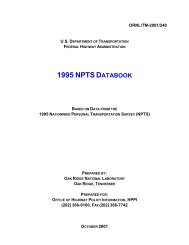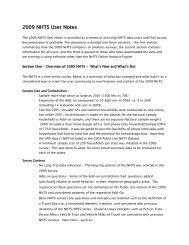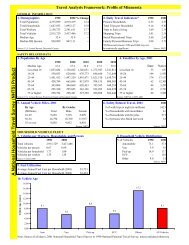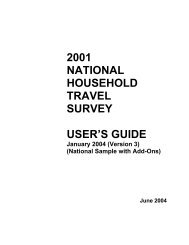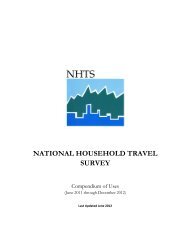Uses of National Household Travel Survey Data in - NHTS Home ...
Uses of National Household Travel Survey Data in - NHTS Home ...
Uses of National Household Travel Survey Data in - NHTS Home ...
You also want an ePaper? Increase the reach of your titles
YUMPU automatically turns print PDFs into web optimized ePapers that Google loves.
Special Population Groups<br />
Changes <strong>in</strong> the Percentage <strong>of</strong> Students Who Walk or Bike to School - United States, 1969 and 2001<br />
Authors:<br />
Ham, Sandra A; Mart<strong>in</strong>, Sarah L; Kohl, Harold W<br />
Journal <strong>of</strong> Physical Activity and Health Issue: 2<br />
2008<br />
Abstract:<br />
This article reports on a study that compared the changes <strong>in</strong> the percentage <strong>of</strong> US students (age 5 to 18<br />
years) who walked or bicycled to school and <strong>in</strong> the distance that they lived from or traveled to their<br />
school <strong>in</strong> 1969 and 2001. The authors also provide detailed <strong>in</strong>formation about school childrens' travel<br />
patterns <strong>in</strong> 2001. <strong>Data</strong> were used from the 1969 <strong>National</strong> Personal Transportation <strong>Survey</strong> report on school<br />
travel and the 2001 <strong>National</strong> <strong>Household</strong> Transportation <strong>Survey</strong>. The results showed that, <strong>in</strong> 2001, a<br />
smaller percentage <strong>of</strong> students (19.4%) lived with<strong>in</strong> 1 mile <strong>of</strong> school than <strong>in</strong> 1969 (when 34.7% <strong>of</strong><br />
students lived less than one mile from their school). The percentage <strong>of</strong> students who walked or biked any<br />
distance decreased from 42.0% to 16.2% <strong>in</strong> the study's two time periods. Nearly half <strong>of</strong> students used<br />
more than 1 travel mode or went to an additional dest<strong>in</strong>ation en route between home and school <strong>in</strong> 2001.<br />
The authors discuss the role <strong>of</strong> commut<strong>in</strong>g to school as part <strong>of</strong> a child's everyday physical activity. Other<br />
topics discussed <strong>in</strong>clude concerns for safety from traffic accidents, distance from school, the impact <strong>of</strong><br />
school choice programs such as magnet schools and desegregation, Safe Routes to School legislation,<br />
student access to vehicles, and complex travel patterns <strong>of</strong> modern American children. The authors<br />
conclude by describ<strong>in</strong>g the multidiscipl<strong>in</strong>ary efforts that will be needed as part <strong>of</strong> any programs to<br />
<strong>in</strong>crease the percentage <strong>of</strong> students who walk or bike to school.<br />
Subject areas and Index Terms<br />
Highways; Passenger Transportation; Pedestrians and Bicyclists; Plann<strong>in</strong>g and Forecast<strong>in</strong>g; Safety and<br />
Human Factors; Society; I72: Traffic and Transport Plann<strong>in</strong>g<br />
Adolescents; Bicycl<strong>in</strong>g; Children; Commut<strong>in</strong>g; <strong>Household</strong>s; Residential areas; School bus passengers;<br />
School buses; School children; Traffic safety; Trip length; Walk<strong>in</strong>g; Walk<strong>in</strong>g distance; Safe Routes to<br />
School (Program)<br />
Availability: F<strong>in</strong>d a library where document is available Order URL: http://worldcat.org/issn/15433080<br />
30



